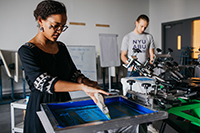A teaspoon of seawater is home to a thousand algae cells and a million bacteria. These tiny critters are fundamental to life on Earth. Ocean algae produce much of the oxygen in the atmosphere and form the base of the marine food chain, while bacteria release carbon dioxide that is converted into organic molecules by algae — and plants — during the process of photosynthesis.
"If you take these organisms out, basically life on Earth ends," said Shady Amin, assistant professor of Chemistry at NYU Abu Dhabi.
Amin has long been fascinated by the hidden interactions that occur between the ocean's microorganisms. "There is a lot of mutual and competitive interactions between species and our goal is to understand how this all works to balance the ecosystem," he said.
In a paper published in Nature, Amin and his colleagues took a step forward in understanding how these interactions happen in the ocean, uncovering a significant chemical exchange between particular kinds of algae — called diatoms — and bacteria that live with them.
Scientists have suspected that bacteria influence the growth of ocean algae and Amin and his colleagues wanted to know if and how these interactions happen. To find an answer, they used a number of different techniques that cross disciplines, including chemistry, genomics, and biology.
"The ultimate goal is to look at the whole ecosystem and to be able to understand how these interactions happen between all these different kinds of organisms.
The researchers took samples of seawater from several locations in the Pacific and one in the Atlantic and isolated a diatom and a bacterium called Sulfitobacter. In the lab, they measured the growth rate of the diatom with the bacterium.
Using antibiotics, the scientists killed the bacteria to get a rate of growth of the diatom on its own. They found that without the bacteria, the diatom grew at a slower rate than it did with bacteria. The bacteria must provide some benefit, but how? Amin then mapped the complex chemical exchange between the algae and Sulfitobacter.
It turns out that the algae and bacteria have an "I scratch your back, you scratch mine" kind of relationship.
The algae soak up sunlight and carbon dioxide and release the amino acids taurine and tryptophan into the soupy mix. The bacteria consume these amino acids, and convert the tryptophan to another molecule commonly called auxin. They then release this molecule back into the water.
Auxin is then ingested by the algae and acts as a kind of fertilizer, increasing the algae's growth rate — up to 35 percent in some cases.
"Our goal is to understand how these phytoplankton are disbursed around the ocean, why there are, for example, some places where you find a lot of phytoplankton and other places where you find very few," Amin said.
This work also has implications in an age of global climate change. "Trying to understand what happens in these communications between organisms is very important because ocean acidification and global warming may disrupt these interactions," Amin said.
Diatoms are also responsible for algal blooms that occur in the ocean. During these blooms, the algae grow rapidly, at a rate much higher than normal. When the algae are consumed by mussels or crustaceans, they leave a neurotoxin that can be harmful if eaten by humans (a recent bloom off the coast of British Columbia closed fisheries up and down the Pacific coast). Understanding how bacteria increase the growth rate of algae may help marine biologists better anticipate these toxic blooms.
Going forward, Amin hopes to carry out similar work. "We're interested to see what happens when you add a third organism to the equation, or a fourth one. But the ultimate goal is to look at the whole ecosystem and to be able to understand how these interactions happen between all these different kinds of organisms," Amin noted. "And that's my main drive, to understand how the whole ecosystem balances itself."


